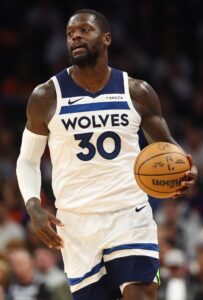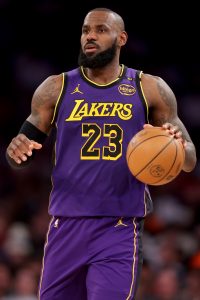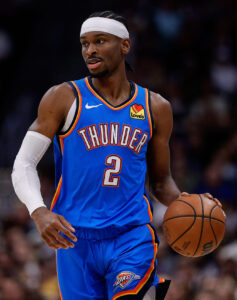The NBA has no shortage of rules affecting which players can and can’t be traded at any given time, which complicates our understanding of which players are actually moveable. That’s especially true leading up to the regular season, when players who recently signed free agent contracts, extensions, and rookie contracts all face different sets of trade restrictions.
In an effort to clear things up, we’re looking today at which players around the NBA are currently affected by trade restrictions of one kind or another. Let’s dive in…
Recently signed free agents
In most cases, a free agent who signed a contract in the offseason is ineligible to be traded until December 15.
 Currently, our list of players who will become trade-eligible on December 15 features 80 names, including several of the guys who signed the biggest free agent contracts of the summer, such as Kyrie Irving, Myles Turner, and Julius Randle.
Currently, our list of players who will become trade-eligible on December 15 features 80 names, including several of the guys who signed the biggest free agent contracts of the summer, such as Kyrie Irving, Myles Turner, and Julius Randle.
But the list is technically even longer than that, since we haven’t included players who signed non-guaranteed Exhibit 9 and/or Exhibit 10 contracts. Most of those players will be waived by opening night, but if they earn spots on regular season rosters, the December 15 trade restriction would apply to them as well.
A free agent who signs after September 15 won’t become trade-eligible until three months after his signing date.
Any player who has his two-way contract converted to a standard deal during the offseason also doesn’t become trade-eligible until December 15 or until three months after the move, whichever comes later. However, no players were promoted from two-way contracts to standard deals this summer. All the players who finished last season on two-ways either became free agents on July 1, were waived, or are still on their previous contracts.
A select group of players who signed free agent contracts this offseason won’t become trade-eligible until January 15. These eight players all meet a specific set of criteria. Not only did they re-sign with their previous team this offseason, but they got a raise of at least 20%, their salary is worth more than the minimum, and their team was over the cap, using Bird or Early Bird rights to sign them.
That group includes Naz Reid, Santi Aldama, and Sam Merrill, among others, and may end up featuring a few more current free agents, such as Josh Giddey, Quentin Grimes, and Jonathan Kuminga.
The above rules apply to players who sign standard contracts, not two-way deals. A player who signs a two-way contract is ineligible to be traded for 30 days. There are currently five players to whom this restriction applies, including Olivier-Maxence Prosper, who signed with the Grizzlies on September 4 and won’t become trade-eligible until October 4.
Two-way players are rarely traded, but it happens every now and then, like when RJ Luis was sent from Utah to Boston in last month’s Georges Niang deal.
Recently signed draft picks
Like a player who signs a two-way contract, a draftee who signs his first NBA contract is ineligible to be traded for 30 days. Currently, this restriction only impacts two players: Celtics second-rounder Amari Williams, who signed on August 15, and Jazz second-rounder John Tonje, who signed on August 26. They’ll become trade-eligible on September 14 and September 25, respectively.
The rest of this year’s draftees can currently be traded.
That list of tradable 2025 draftees includes all the players besides Williams and Tonje who have signed, since more than 30 days have passed since their officially completed their deals.
It also includes the two players who remain unsigned – including Warriors second-rounders Alex Toohey and Will Richard – since their draft rights can be traded until they sign their contract. If Toohey and Richard officially sign NBA contracts for 2025/26, they’ll become trade-ineligible for 30 days.
Players with veto ability
 Lakers forward LeBron James and Trail Blazers guard Damian Lillard are the only NBA players who have genuine no-trade clauses in their contracts, but several other players have the ability to veto trades this season due to various quirks of the Collective Bargaining Agreement.
Lakers forward LeBron James and Trail Blazers guard Damian Lillard are the only NBA players who have genuine no-trade clauses in their contracts, but several other players have the ability to veto trades this season due to various quirks of the Collective Bargaining Agreement.
Clippers guard James Harden, Rockets guard Fred VanVleet, Nets guard Cam Thomas, and Magic big man Moritz Wagner are some of the notable players whose consent will be required to trade them during the 2025/26 season.
Under the current CBA, a player who would normally meet the no-trade criteria due to re-signing with his current team on a one-year contract (or a two-year deal with a second-year option) can opt to waive his right to veto a trade.
At least a dozen players have done so this season so far, including Bucks guard Kevin Porter Jr., Lakers center Jaxson Hayes, and Mavericks guard Dante Exum, so once they become trade-eligible (on either December 15 or January 15), they can be moved without any issue.
Players who have signed veteran extensions
A player who signs a rookie scale extension becomes more difficult to trade due to the “poison pill provision,” but he could theoretically be moved immediately.
That’s not necessarily the case for a player who signs a veteran contract extension. A player who signs a veteran extension becomes ineligible to be traded for the next six months if he meets any of the following criteria:
- His extension locks him up for more than four total years (including his current contract).
- The extension includes a first-year bump of more than 20% (or more than 20% above the NBA’s estimated average salary, if his previous salary is below that average).
- His extension includes an annual increase or decrease exceeding 5% anytime after the first year of the deal.
With the help of our extension trackers, here are the players currently affected by that rule, along with the dates they’ll become trade-eligible:
- December 14: Steven Adams (Rockets)
- December 29: Jaylin Williams (Thunder)
- January 7: Jakob Poeltl (Raptors)
- January 10: Devin Booker (Suns)
- January 13: Jaren Jackson Jr. (Grizzlies)
- January 14: Herbert Jones (Pelicans)
- February 1: Mikal Bridges (Knicks)
- February 2: Luka Doncic (Lakers)
- February 4: De’Aaron Fox (Spurs)
Since the trade deadline will land on February 5, a player who finalizes an extension between now and then (such as Mavericks forward P.J. Washington) wouldn’t become trade-eligible until the 2026 offseason.
Mavericks big man Daniel Gafford also signed an extension this offseason, but his deal didn’t exceed four total years, include a first-year bump exceeding 20%, or feature any subsequent annual raises greater than 5%, meaning he remains eligible to be traded.
Players who have signed Designated Veteran extensions
 A Designated Veteran contract is also known as a “super-max” deal — it’s a maximum-salary contract that starts at 35% of the cap instead of 30% because the player has met certain performance criteria before achieving 10 years of NBA service.
A Designated Veteran contract is also known as a “super-max” deal — it’s a maximum-salary contract that starts at 35% of the cap instead of 30% because the player has met certain performance criteria before achieving 10 years of NBA service.
A player who signs a Designated Veteran contract or extension can’t be traded for one full year after his signing date.
Only one player has signed a super-max contract this offeason: Thunder guard Shai Gilgeous-Alexander. He’ll become trade-eligible on July 7, 2026, the one-year anniversary of his signing.
Players affected by aggregation restrictions
When a team trades for a player via salary-matching or using an exception (ie. not by absorbing the player into cap room), that team can’t “aggregate” the player in another trade for two months. Aggregating a player means combining his salary with another player’s for matching purposes.
The majority of the trades made this offseason so far were completed in June or early July, at least two months ago, so this restriction only applies to a handful of players at the moment. Here are those players, along with the dates when they’ll become aggregation-eligible:
- September 9
- Kelly Olynyk (Spurs)
- Malaki Branham (Wizards)
- September 13
- Dario Saric (Kings)
- Jonas Valanciunas (Nuggets)
- October 6
- Georges Niang (Jazz)
Any player who is traded this season after December 16 (without being acquired via cap room) won’t be eligible to be flipped prior to the trade deadline in a second deal that aggregates his salary with another player’s.
This aggregation restriction also applies indefinitely to any player on a team who is operating over the second tax apron. Currently, only the Cavaliers fit that bill.
Wow thse tariffs are messing with everyone
don’t give the king any ideas or he will put tariffs on foreign players claiming they are taking American player’s jobs.
I misunderstood trade restrictions but you are right…